One
Great Year Archive – IV
This
feature discusses a season in which a team finished much higher than they
did in the immediate past or future or a player far surpassed any other
year of his career.
|
Austin McHenry 1921
The previous articles in this series featured players who had one year where everything clicked at bat or on the mound. This tale tragically does not follow that script.
Heading into the 1922 season, Austin McHenry of the St. Louis Cardinals was considered one of the very best players in the National League.
- In his fourth season with St. Louis, McHenry put it all together.
- BA - .350
- H - 201
- R - 92
- RBI - 102
|
- 2B - 37
- 3B - 8
- HR - 17
- SLG - .531
|
- Austin would have led the league in batting average and slugging % were it not for his teammate Rogers Hornsby, who compiled these incredible stats, where all the bold numbers led the league:
- BA - .397
- H - 235
- R - 131
- RBI - 126
|
- 2B - 44
- 3B - 18
- HR - 21
- SLG - .639
|
- As it was, McHenry finished in the top five in the NL in the categories that are in bold in his list above.
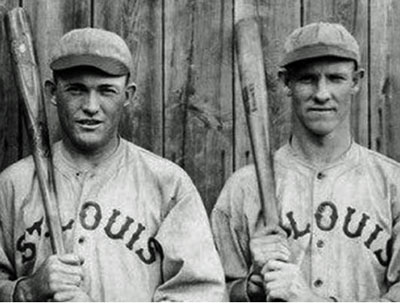
Rogers Hornsby (L) and Austin McHenry started professional ball in 1915 at age 19 in Class D and moved up the ladder year by year.
- In 1917, he was at AA Milwaukee. A beaning when he was with the Brewers may have had effects that could not be predicted at that time. He resumed playing after a short rest.
- Branch Rickey, the vice president (today's GM) as well as the manager of the Cardinals, purchased McHenry on June 12, 1918.
- The next season he split time between St.Louis and Milwaukee.
- 1919 saw him with the Cardinals the entire season, appearing in 110 games. Writers compared him to Ed Delahanty and Ty Cobb because of his "arm of steel" and the fact that he was a "veritable demon at the bat."
- Shaky on defense at first, he made up for it with a strong, accurate throwing arm as evidenced by his 14 assists, which put him in the top 10 among NL outfielders despite playing in only 80 games.
- The Knothole Gang youngsters in the LF bleaches became great fans of the young LFer.
Rickey ordered his coaches to work with the youngster during spring training of 1919 to work on both his batting and his fielding.
- Starting the season as the Cards' fourth outfielder, he supplanted the injured Burt Shotton as the regular LF by June.
- McHenry improved across the board that year: .286 BA, 65 RBI, 66 R, .423 SLG.
- In the starting lineup from the start of the 1920, he increased all his numbers except BA (down slightly to .282 from .286): 65 RBI (+18), 66 R (+25), 19 doubles and 11 triples - both oddly the same as the previous year, and 10 HRs instead of one. His numbers were undoubtedly inflated by the switch to a more tightly wound ball in 1920 and the banning of the spitball, two changes that marked the end of the "Deadball Era."
- Adding to his value, he committed only three errors and recorded 20 assists, fifth best in the NL, despite shifting between LF and CF in the makeshift Cardinal outfield.
- The Reds, realizing their mistake in selling McHenry to the Cardinals in 1917, offered Rickey $25,000 for him, but Branch rejected the offer. A newspaper article in September 1921 called McHenry "one of the most talented outfielders to break into fast company in some years" and one of the "reigning sensations" of the big leagues.
That presaged his breakout season of 1921.
- His campaign was so impressive that The Sporting News named him one of the ten best LFers in baseball history. The writer added, "McHenry is without a question one of the game's greatest outfielders. And he is one of the game's greatest hitters."
- One person who was impressed by Austin was Giants manager John McGraw, who offered Rickey $50,000 for McHenry that winter. But Branch refused to budge.
McHenry started the '22 season where he left off in '21.
- By mid-June, his average had risen to .332 and he was slugging at a .511 clip. He seemed certain to equal, if not surpass, his 1921 numbers.
- But he didn't sustain the torrid pace. He batted only .191 in his last eleven June games to drop his average to .306. That brought out the boo birds.
An incident in a game June 26 alarmed Rickey and made him suspect something was happening to his prized LFer.
- McHenry started struggling to catch fly balls. When Rickey asked him if he was okay, Austin replied, "Yes, I feel alright, but I can't see. I don't know what it is. Maybe I'm going blind." The spot on his forehead where he had been beaned six years earlier had become sore again.
- Rickey removed Austin from the game and ordered him to go home to Ohio to rest. He didn't rejoin the team until late July.
- He went 0-for-4 in his first game. Then he didn't play until three days later when he pinch hit, getting a single in what would prove to be his last at-bat.
- Seeing how much his young phenom was struggling, Rickey sent him home again.
McHenry was admitted to Good Samaritan Hospital in Cincinnati.
- Doctors discovered a brain tumor and recommended a risky operation to remove it.
- The God-fearing McHenry told relatives, "It seems hard that so young a man as I must die, but I am ready when the Master summons me." Right before the operation, he told Rickey that he felt like he was up to bat with the bases loaded with a 3-2 count but promised to "hit at the next one."
- The operation took place October 19. Doctors could not remove the entire tumor because of its location. Still, they hoped Austin could make a full recovery.
- However, that didn't happen. He was sent home less than a month after the operation and five days later he died with his wife and two children at his side. He was only 27 years old.
- Rickey, a very religious man himself, issued this statement: "We do not look upon the death of Austin as that of a ballplayer, but as a dear friend. He was one of our most popular players and was a particular favorite of the younger fans ..."
- In its obituary, the Sporting News said: "No ball club ever had a more loyal player and there are few outfielders in the game today who are as good as McHenry was at his best. His death is a distinct loss to baseball."
Reference: Baseball's Untold History: The People, Michael Lynch (2015) |

Snuffy Stirnweiss
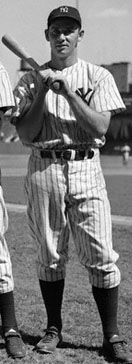
Joe Gordon

Joe McCarthy
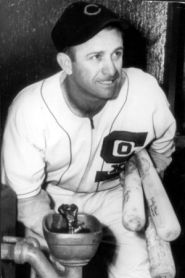
Tony Cuccinello
|
Snuffy Stirnweiss 1945
George "Snuffy" Stirnweiss had an excellent 1944 season and an even better 1945 campaign.
- The Yankees' 2B led the American League in the following categories in 1945:
- Plate appearances - 718
- AB - 632
- R - 107
- H - 195
- 3B - 22
- SB - 33
|
- BA - .309
- Slg. % - .476
- OPS - .862
- OPS+ - 145
- Total Bases - 301
|
His .309 average was the third lowest ever for an AL champion.
- He also led the Junior Circuit the previous year, 1944, in five of those categories and had high numbers in another five. (League highs are bold.)
- PA - 723
- R - 125
- H - 205
- 3B - 16
- SB - 55
|
- BA - .319
- Slg. % - .460
- OPS - .849
- OPS+ - 139
- TB - 296
|
- Snuffy hit .319 that season, ten points higher than a year later, but finished fourth behind Cleveland SS Lou Boudreau's .327.
- In the other seven seasons of his career, Snuffy had these highs.
- PA - 673
- AB - 571
- R - 102
- H - 146
|
- 3B - 8
- SB - 18
- BA - .256
- Slg. % - .342
|
How did a journeyman ballplayer produce two of the best seasons any hitter ever had?
- By 1944, World War II had diverted the vast majority of major league baseball players into the armed services.
- 1945, the last year of the war, saw the biggest percentage of 4F's, has-beens, never-wases, and rookies in the two leagues.
- So Stirnweiss was facing very few major league-quality hurlers.
That begs the question: Why wasn't Snuffy serving in the military?
- Stirnweiss, who got his nickname because of a lifelong sinus condition, was rejected for service because of gastric ulcers, which had plagued him since college.
- He stole an International League record 73 bases in 1942 for the Yankees' farm club in Newark (NJ).
- He joined the parent club for 1943 but, with Joe Gordon, the reigning AL MVP, holding down 2B, manager Joe McCarthy switched Stirnweiss to SS. But he hit only .219 in 83 games.
- McCarthy liked the scrappy, hustling rookie infielder and had him sit beside him in the dugout so he could impart his wisdom to him every game.
- When Gordon entered the military, Snuffy played 2B in 1944 and served as McCarthy's leadoff man. By midseason, Joe was calling him "the best second baseman in the game today." That was certainly true for the depleted personnel that filled ML rosters.
In 1945, Stirnweiss enjoyed an even better season.
- Watching his old club struggle to finish fourth, Babe Ruth praised Snuffy. "That sawed-off runt playing second base is the only ballplayer who could have gotten a uniform when the Yankees had a real ball club."
- Stirnweiss roared from behind to overtake Tony Cuccinello of the White Sox for the batting title. Hitting .297 entering play on September 20, nine points behind Cuccinello, Snuffy ripped multiple hits in each of his next four games.
- He finished with a flourish, going 3-for-5 in each of his last two games to overtake Cuccinello, who sat helplessly as his last three games were rained out.
Cuccinello was a prime example of a player who occupied a spot on a big league roster only because of World War II. An All-Star with the Dodgers (1933) and Braves (1938), Tony had played in fewer than 40 games in each of the war seasons of 1942, 1943, and 1944.
When the troops came home for the 1946 season, Stirnweiss kept his spot in the starting lineup at 2B.
- The Yankees traded Gordon to Cleveland before the 1947 season in which the Yankees captured the pennant and the World Series under new manager Bucky Harris.
- Facing true ML pitching, Snuffy hit .251 in '46 and .256 in '47. He compiled a .259 average in the seven-game Fall Classic.
- 1948 was his last year as the Yanks' regular 2B. He hit .252 in 141 games.
- Jerry Coleman started most of the games at the keystone sack for new manager Casey Stengel in 1949.
- Stirnweiss hung on for another two seasons before retiring.
|

Johnny Kucks

Bob Grim
|
One Great Year: Johnny Kucks 1956
Johnny Kucks won 42 games for the Yankees from 1955-59. 43% of those victories came in 1956.
- Born in Hoboken NJ, Kucks grew up in Jersey City, just across the Hudson River from New York City.
- After compiling a 19-6 record at Norfolk of the Piedmont League in 1952, the 19-year-old hurler spent the next two seasons in the military.
- After a stint at the Yankees' instructional school, Kucks joined the Yankees for spring training in 1955. He threw a fast ball and sinker with professional control.
- Johnny's roommate was P Bob Grim, the AL Rookie of the Year in 1954 after two years of military service.
- Amazingly, Kucks made the Yankee roster and went 8-7 in 29 games, including 13 starts. He pitched three innings in the World Series, which the Dodgers won in seven.
Those statistics did not prepare the American League for what Kucks did in 1956.
- Peter Golenbock: In the spring of 1956 Kucks continued to be outstanding, throwing with a loose-jointed, easy three-quarter motion, imparting a heavy over-spin on the ball that caused batters to break their bats and sting their hands if they didn't meet the ball just right. The fielders enjoyed playing behind Kucks because he pitched quickly.
- Part of the starting rotation from the beginning of the season, Kucks won 18 and lost only 9. He twirled 12 complete games and finished with a 3.56 ERA. Only Whitey Ford (19-6) tallied more victories.
- The Yankees won the pennant by 9 games over Cleveland.
The 1956 World Series is remembered for Don Larsen's perfect game, but Kucks was also a hero.
- Johnny appeared in relief in the first two games at Ebbets Field, both Brooklyn victories.
- For the third straight time, a Dodger-Yankee Series went to the seventh game.
- Casey Stengel chose Kucks, who responded with a three-hit shutout as the Yanks romped 9-0. His sinker working, Johnny allowed only two fly balls all afternoon.
The momentum from the Series finale didn't carry over to 1957 for Kucks.
- He started 23 games but finished only 10. His final tally showed only 8 wins against 10 losses.
- Ironically, his ERA actually dropped to 3.56.
- He pitched only 2/3 of an inning in the '57 Fall Classic.
Kucks stayed stuck on eight for the rest of his career.
- He won only 8 again in '58, leading to his trade to the Kansas City Athletics early in the '59 campaign.
- He contributed eight victories to the A's in '59 but dropped to just 4-10 with a 6.00 ERA in '60.
- After three years in the minors with no call back to the majors, Johnny retired after the '63 season.
Reference: " Dynasty: The New York Yankees 1949-1964, Peter Golenbock (1975)
Top of Page |
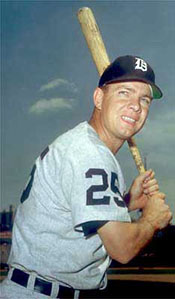
Norm Cash
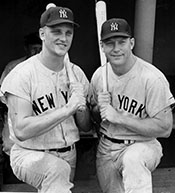
Roger Maris, Mickey Mantle
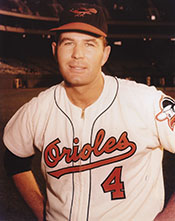
Jim Gentile
|
One Great Year: Norm Cash 1961
Norm Cash began his major league career with the Chicago White Sox in 1958 at age 23.
- His minor league stats were good. He hit .290 and .334 in the Class B Three-I League.
- After serving in the military in 1957, he hit .247 in 81 at-bats at the AAA level.
- After appearing in 13 games as an outfielder with the White Sox in 1958, he saw action in 58 contests in '59, playing mostly at first base in the latter year.
- In the two seasons, he got 27 hits in 112 at-bats for an uninspiring .241 average.
- On December 6, 1959, Chicago GM "Trader Frank" Lane sent Cash along with Bubba Phillips and John Romano to the Cleveland Indians for Dick Brown, Don Ferrarese, Minnie Minoso, and Jake Striker. (In this instance, the words that are often used - "traded for two players and Cash" - have a different meaning.)
- The fact that you may not recognize any of the names in the transaction except Minnie Minoso (who was 34 at the time) shows that this wasn't a blockbuster trade by any means.
- But before Cash could play a regular season game for the Indians, he was traded to the Detroit Tigers on April 12, 1960, for 3B Steve Demeter, a seven-year minor leaguer.
- Installed at first base, Cash had a solid 1960 season in his first year in the Motor City:
Games - 121, Avg. - .286,
RBI - 63, HR - 18, Runs - 64, Slg. % - .501.
Nothing Norm had done before prepared anyone for what he did in 1961 at age 26.
- He went 1-for-4 in his first two games. His .250 average at that point would be his lowest of the entire season
- With averages fluctuating wildly at the beginning of the season before players built up a large number of at-bats, he didn't fall below .300 after April 24.
- Here are his month-by-month averages:
April - .333
May - .333
June - .416
July - .361
August - .365
September - .340
- In the middle of August, Norm went three games in a row without a hit for the only time all season to drop his average to .351. But he got out of that little slump fast, going 20-for-34 to raise his average to .370.
- As you'd expect from a left-handed hitter, he had a much better average against righties.
Vs righthanders - .392
Vs lefthanders - .269
- His final numbers are mind-boggling. The bold numbers signify league-leading stats.
Games - 159, Hits - 193, Runs - 119, RBI - 132, HR - 41, BA - .361 (tops in both leagues), OBP - .487, SLG - .662, OPS - 1.148
- Norm finished 4th in the AL MVP voting. It was his bad luck that Roger Maris clouted 61 roundtrippers that season to break Ruth's record and Mickey Mantle smashed 54. The two Yankee sluggers finished 1-2 in the MVP race, and Jim Gentile of Baltimore came in 3rd, six points ahead of Cash.
- The '61 Tigers finished 2nd behind the Yankees for the franchise's best finish since 1950.
How did a journeyman ballplayer suddenly produce one of the best seasons any hitter ever had?
- One factor in his super year might have been his corked bat. In a Sporting News article in the mid-1970s, Cash explained how he made corked bats in his home woodshop. However, no evidence has been amassed to show that a corked bat provides a physical edge to a hitter. You gain in bat speed but lose bat mass.
- Years later, Cash gave this explanation. Even at the time, I knew that (1961) season was a freak. Everything I hit seemed to drop in, even when I didn't make good contact. I never thought I'd do it again.
|
While Stormin' Norman, as Tiger radio broadcaster Ernie Harwell branded him, had some more good seasons, he never came close to matching his '61 success.
- Here's Cash's numbers the rest of the career.
| Year |
Hits |
Bat.Avg. |
R |
RBI |
HR |
OBP |
SLG |
| 1961 |
193 |
.361 |
119 |
132 |
41 |
.487 |
.662 |
| 1962 |
123 |
.243 |
94 |
89 |
39 |
.382 |
.513 |
| 1963 |
133 |
.270 |
66 |
79 |
26 |
.386 |
.471 |
| 1964 |
123 |
.257 |
63 |
83 |
23 |
.351 |
.453 |
| 1965 |
124 |
.266 |
79 |
83 |
30 |
.371 |
.512 |
| 1966 |
168 |
.279 |
98 |
93 |
32 |
.351 |
.478 |
| 1967 |
118 |
.242 |
64 |
72 |
22 |
.352 |
.430 |
| 1968 |
108 |
.263 |
50 |
63 |
25 |
.329 |
.487 |
| 1969 |
135 |
.280 |
81 |
74 |
22 |
.368 |
.464 |
| 1970 |
96 |
.259 |
58 |
53 |
15 |
.383 |
.441 |
| 1971 |
128 |
.283 |
72 |
91 |
32 |
.372 |
.531 |
| 1972 |
114 |
.259 |
51 |
61 |
22 |
.338 |
.445 |
| 1973 |
95 |
.262 |
51 |
40 |
19 |
.357 |
.471 |
- As you can see, he never hit above .300 again, never score or drove in 100+ runs, and never hit more than 40 HRs. The 118 points his average dropped from '61 to '62 is a major league record.
- His 1962 season was not bad. Despite having just a .243 batting average, he scored 94 runs and drove in 89 with 39 HR.
- In addition to 1961, when he made both All-Star games during the brief period when baseball had two Summer Classics each season, he made the AL roster in 1966, 1971, and 1972.
- Norm's 373 HRs remains second only to Hall of Famer Al Kaline in franchise history although Miguel Cabrera will probably pass him in the next year or two.
- Cash tragically drowned at the early age of 52.
Steve Treder, writing for hardballtimes.com, offers Norm Cash's 1961 season as a prime example of a fluke.
You look up “fluke” in the dictionary, and all they need to show is a picture of his 1961 baseball card. Norm Cash wasn’t really a hitter comparable to Mickey Mantle or Stan Musial or Ted Williams or Babe Ruth or Barry Bonds.
But Norm Cash really did compile a season in which he hit like those guys, not just sort of like them, but very comparable to their very best years. Cash actually did perform, for a single season, at a level quite consistent with the very best hitters in the history of baseball. It actually happened.
One Great Year: 1980 Oakland A's Starters
Four starters for the 1980 Athletics recorded the highest number of victories in their careers before or after that season.
- This was no coincidence but rather a result of manager Billy Martin's philosophy.
- Billy adopted the old school approach - he expected his pitchers to finish what they started.
- As Ben Bolch wrote in 2011, "Slipping on an Oakland A's jersey as a starting pitcher 30 years ago meant being dressed for the nines. Come hell or high-water pants with socks pulled to the knees, Manager Billy Martin expected his starters to throw a complete game - pitch counts be damned."
Here's the relevant statistics for the 1980 Athletics' top four starters, all right handers.
| Pitcher |
Age |
W |
L |
ERA |
GS |
CG |
| Rick Langford |
28 |
19 |
12 |
3.26 |
33 |
28 |
| Mike Norris |
25 |
22 |
9 |
2.53 |
33 |
24 |
| Matt Keough |
24 |
16 |
13 |
2.92 |
32 |
20 |
| Steve McCatty |
26 |
14 |
14 |
3.86 |
31 |
11 |
Oakland easily led the majors in complete games.
- The A's 94 complete games topped second place Baltimore by a whopping 52!
- The NL leader, St. Louis, had only 34 complete games.
- Langford, Norris, and Keough ranked 1-2-3 in the majors in complete games. The NL leader, Steve Rogers, finished a paltry 14 starts.
- Langford and Norris also stood atop the league in innings pitched with 290 and 284 respectively. However, Steve Carlton of the Phillies led the majors with 304 IP.
- Langford twirled 22 consecutive complete games from May 23 to the end of the 1980 season.
- Keough won AL Comeback Player of the Year after a 2-17 nightmare in 1979.
Martin claimed he wanted his starters to go the distance because he believed he had the best rotation ever assembled.
- But, as you might suspect, the real reason was The Brat's distrust of his bullpen.
- "Let's face it," Norris said. "We didn't have any Dennis Eckersleys out there."
Pitch counts were kept in those days but rarely used to determine when a starter should be pulled.
- Langford averaged 110 pitches per nine innings. McCatty usually threw 130-140 pitches when he went the distance.
- Each of the four pitched a 14-inning complete game during the 1980 season. Norris needed 152 pitches to get through his marathon.
- But that was nothing compared to McCatty, who fired an astronomical 207 pitches in his 14-inning stint. When Martin came out in the 11th to find out how his pitcher was holding up, McCatty told him, "I'm staying out here one way or another. I'm getting a win or a loss." It was a loss, 2-1 to the Mariners on Dan Meyer's HR.
- The hurlers knew Martin was only going through the motions when he checked on them late in the game. "If you told him you were tired, he would look at you like you were less of a man," recalled Norris. "So I told him to get the hell out of there. Of course you're tired. But it's a gut-check. It's a matter of intestinal fortitude at that point."
- Peer pressure built up also. One time, McCatty was shelled and lasted only 1 2/3 innings. So he came back the next day and lasted 8 1/3 in a victory over Seattle. CF Dwayne Murphy teased him, "What, you can't go nine?"
When Martin arrived in 1980, Oakland had fallen on hard times after winning the World Series three years in a row (1972-73-74).
- 1975 - won the AL West but were swept by the Red Sox in the ALCS.
- 1976 - 2nd in the West
- 1977 - 7th, 38.5 GB
- 1978 - 6th, 23 GB
- 1979 - 7th, 34 GB with 108 losses
As he did every place he managed, Martin put a charge into the A's in 1980.
- They went from 52 victories in '79 to 83, good enough for 2nd place in the AL West.
- In 1981, the strike-shortened season, Oakland won the 1st half (prestrike) West title by 3.5 games. Then they finished 2nd to Kansas City when play resumed but swept the Royals in the three-game playoff for the West crown. Then the Yankees swept them to take the AL pennant.
All that work took its toll on "the best rotation ever."
- Langford never came close to 19 wins again, his highest being 12 in the abbreviated '81 campaign and 11 the following season. When he developed elbow trouble in '83 after leading the club in innings for the fourth straight year, Rick didn't join the chorus of those blaming Martin for his plight. He completed only four years of a six-year contract before bottoming out at 1-10 in 1986.
- Norris, the most promising of the four iron men, also won 12 in '81 but fell to 7, then 4, and was finished at age 29, in part because of drug use.
- Keough continued with double-digit victory totals in '81 (10) and '82 (11, although with a league-high 18 losses) before dropping off to 5 in '83. Midway through that seaon, the Yankees traded for him but got only three wins for their trouble.
- The story was essentially the same for McCatty. After topping the AL with 14 victories in '81, he won only 24 more over the next four years. Steve is currently the pitching coach for the Washington Nationals. (Does he pay attention to pitch counts?)
Billy Martin did baseball a favor in 1980-81 by showing that pitch counts are important and overworking your hurlers can considerably shorten their careers.
Reference: "Thirty years ago, Oakland A's pitchers generally finished what they started,"
Ben Bolch, Los Angeles Times, 7/18/2011
Top of Page |
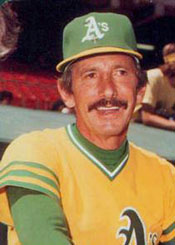
Billy Martin
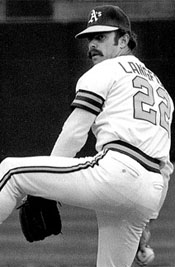
Rick Langford

Mike Norris

Matt Keough
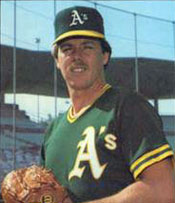
Steve McCatty
|
|
|













